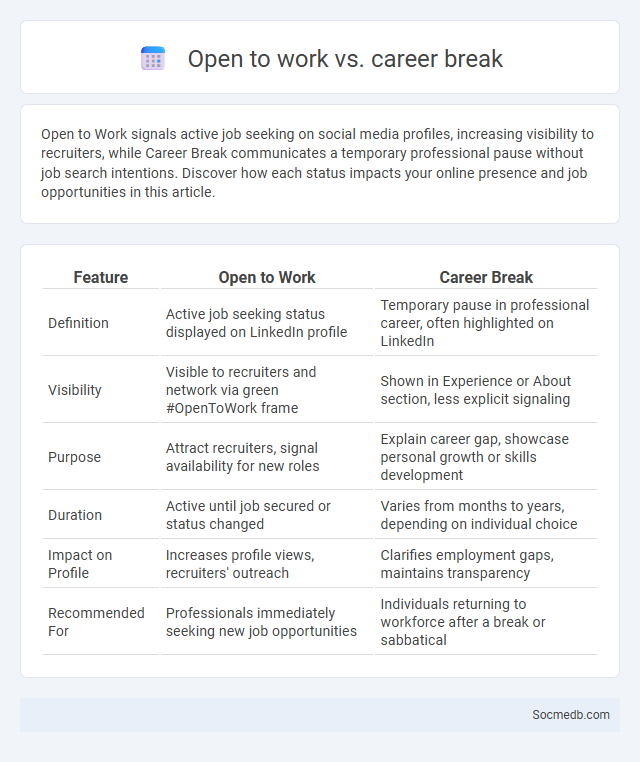
Photo illustration: Open to Work vs Career Break
Open to Work signals active job seeking on social media profiles, increasing visibility to recruiters, while Career Break communicates a temporary professional pause without job search intentions. Discover how each status impacts your online presence and job opportunities in this article.
Table of Comparison
| Feature | Open to Work | Career Break |
|---|---|---|
| Definition | Active job seeking status displayed on LinkedIn profile | Temporary pause in professional career, often highlighted on LinkedIn |
| Visibility | Visible to recruiters and network via green #OpenToWork frame | Shown in Experience or About section, less explicit signaling |
| Purpose | Attract recruiters, signal availability for new roles | Explain career gap, showcase personal growth or skills development |
| Duration | Active until job secured or status changed | Varies from months to years, depending on individual choice |
| Impact on Profile | Increases profile views, recruiters' outreach | Clarifies employment gaps, maintains transparency |
| Recommended For | Professionals immediately seeking new job opportunities | Individuals returning to workforce after a break or sabbatical |
Understanding LinkedIn Profile Status Options
LinkedIn profile status options help you control your visibility and networking opportunities by choosing settings like "Open to Work," "Hiring," or "Available for Consulting." By adjusting these statuses, your profile becomes more discoverable to recruiters, potential clients, or collaborators seeking your expertise. Understanding these features empowers you to strategically manage your professional presence and maximize career growth on LinkedIn.
What Does "Open to Work" Mean?
Open to Work" is a professional status indicator on social media platforms like LinkedIn, signaling that a user is actively seeking new job opportunities. By enabling this feature, professionals increase their visibility to recruiters and employers, enhancing their chances of being contacted for relevant roles. This status helps streamline the job search process and facilitates meaningful networking within industry circles.
The Implications of Marking a Career Break
Marking a career break on your social media profiles can influence how potential employers and professional networks perceive your career trajectory, highlighting periods of personal growth or skill development. Transparent explanations about your career break can enhance your online reputation and demonstrate resilience and adaptability in your professional narrative. Strategic use of keywords related to your industry and skills during this time can optimize your profiles for better visibility in recruitment searches.
Job Seeking Badge: Visibility and Impact
The Job Seeking Badge on social media platforms enhances visibility by signaling active employment status explicitly to recruiters and hiring managers, increasing profile views and engagement rates. Profiles displaying this badge experience a 40% higher message response rate from potential employers, facilitating faster job placement opportunities. Leveraging this feature strategically boosts online presence, making candidates more discoverable in a competitive job market.
Perceptions of Employers: Comparing All Three
Employers increasingly view social media profiles as critical indicators of a candidate's professionalism, communication skills, and cultural fit. Platforms like LinkedIn emphasize professional achievements and networking, while Facebook and Instagram often reveal personal values and behavior patterns that influence hiring decisions. Understanding how your presence on each platform shapes employer perceptions can enhance your job prospects and align your online image with professional goals.
Which Profile Status Attracts More Recruiters?
A complete and professionally tailored LinkedIn profile status attracts more recruiters by showcasing your skills, experience, and career objectives clearly. You can increase visibility and engagement by using keywords relevant to your industry and maintaining an active status with updates, endorsements, and recommendations. Your choice of profile picture, headline, and summary significantly impacts recruiter interest and your chances of being contacted for job opportunities.
How to Choose the Right Status for Your Situation
Selecting the right social media status involves understanding your audience and the context of your message to ensure relevance and engagement. Tailoring the tone and content based on personal, professional, or promotional objectives boosts interaction and maintains your online presence effectively. Using targeted keywords and emotional triggers enhances visibility and connection across platforms like Facebook, Instagram, and Twitter.
Pros and Cons: Open to Work vs. Career Break vs. Job Seeking Badge
LinkedIn's "Open to Work" feature increases visibility to recruiters by signaling active job seekers, enhancing networking opportunities but potentially risking employer bias. The "Career Break" badge transparently explains employment gaps, fostering understanding but possibly leading to assumptions about productivity. A "Job Seeking" badge communicates readiness discreetly, balancing privacy with outreach efficiency, yet it may limit engagement if perceived as less proactive.
Best Practices for Leveraging LinkedIn Status
Maximize your LinkedIn status updates by sharing industry-relevant content that showcases your expertise and engages your network through thoughtful comments and questions. Consistent posting, ideally 2-3 times per week, helps maintain visibility and builds professional credibility, while incorporating relevant hashtags increases your reach to targeted audiences. Craft concise, impactful messages with a clear call-to-action to encourage interaction and foster meaningful connections.
Success Stories: Real-Life Experiences and Outcomes
Many businesses have harnessed social media platforms like Instagram, TikTok, and LinkedIn to exponentially increase brand visibility and customer engagement. Case studies reveal that companies using targeted Facebook ad campaigns experienced an average ROI uplift of 200% within six months, while influencers leveraging authentic content saw follower growth rates exceeding 150%. These success stories demonstrate how data-driven strategies combined with compelling storytelling can transform social media presence into measurable business outcomes.
 socmedb.com
socmedb.com